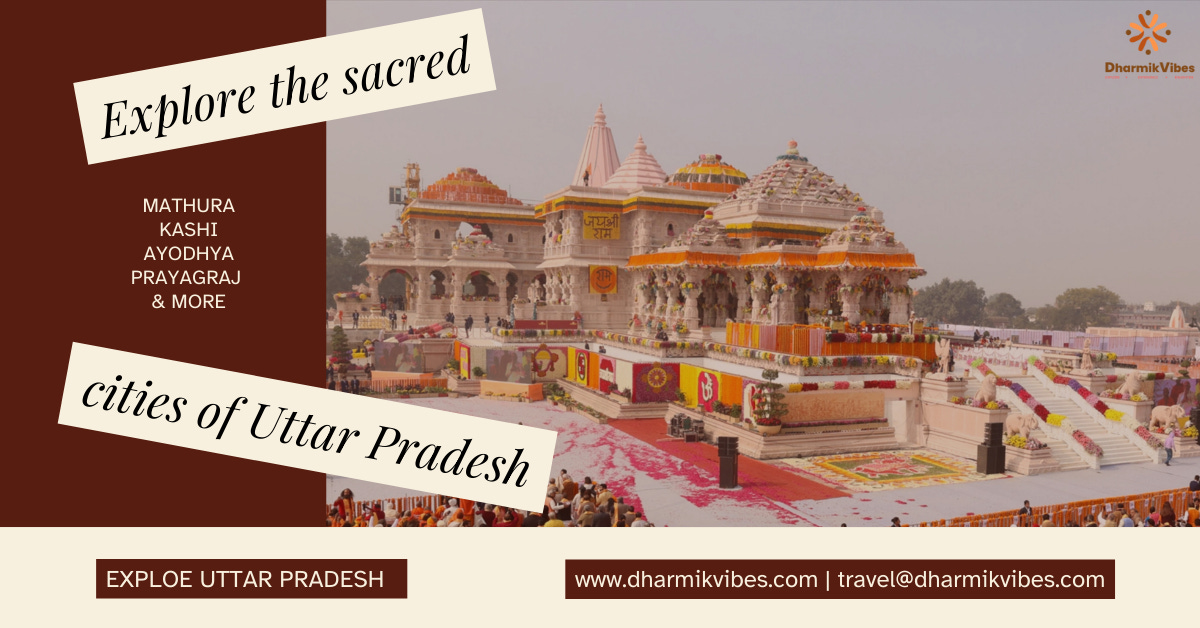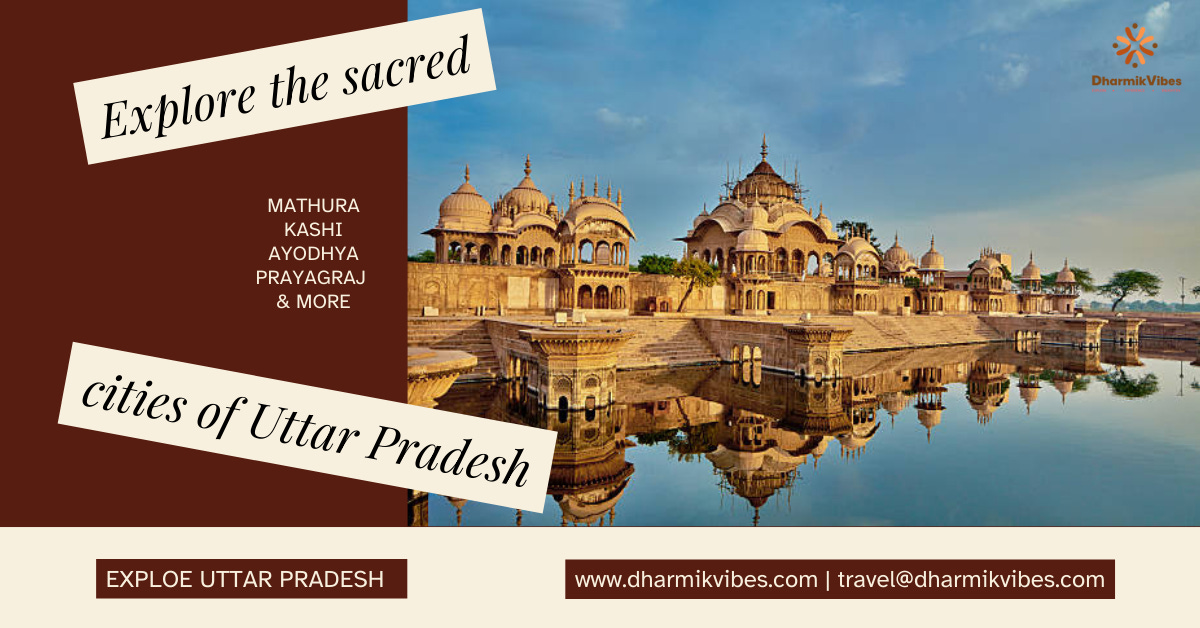Uttar Pradesh Religious Series Part 3: Rural Tirths and Lesser-Known Sacred Places of Uttar Pradesh
Uttar Pradesh’s spiritual landscape is not confined to the bustling cities and renowned pilgrimage hubs. Scattered across its vast rural expanse are countless temples, shrines, sacred groves, and water bodies that have been revered by local communities for generations. In this section, we explore these remote and often underappreciated tirths—places where spirituality is woven into the very fabric of everyday life.
1. The Rural Tirths: A Glimpse into the Heart of Devotion
a. Village Shrines and Sacred Groves
Local Shrines in the Countryside:
In many small villages across Uttar Pradesh, modest shrines dedicated to deities like Lord Shiva, Goddess Durga, and local folk deities serve as the focal point of community worship. These sites, often consisting of simple stone or mud structures adorned with colorful paintings and carvings, are maintained by families or local priests whose lineage of spiritual custodianship spans centuries.
Example – Chandauli Village Temples: In villages like Chandauli, small temples serve not only as places of worship but also as community centers where villagers gather for collective prayers, festive rituals, and cultural celebrations. Annual processions on foot, where devotees carry local deities through the village lanes, exemplify the deep-rooted devotional practices of rural Uttar Pradesh.
Sacred Groves and Forest Shrines:
Another distinctive feature of rural spirituality in the state is the presence of sacred groves—areas of forest or natural vegetation set aside for religious observance.
Example – Dev Van in Mau District: In certain parts of the Mau district, patches of ancient woodland known as “Dev Van” are considered abodes of divine energy. Locals believe that these groves are home to the spirits of ancestors and guardian deities, and they perform seasonal rituals that involve offerings of flowers, rice, and incense.
Ecological and Spiritual Integration: These groves also serve an ecological function, preserving native flora and fauna while offering a tranquil retreat for meditative practices and small gatherings during lunar festivals.
b. Water Bodies and Riverine Tirths
Ponds, Wells, and Small Rivers:
While the mighty Ganges and Yamuna dominate the religious narrative of Uttar Pradesh, many rural communities revere smaller water bodies as sacred.
Example – The Kalindi Kund in Banda: In rural Banda, a modest pond known as Kalindi Kund is believed to have been blessed by the presence of the river goddess Kalindi. Devotees visit this pond on auspicious days for ritual bathing and to perform “pind daan” (offerings to ancestors).
Local Rituals: These water bodies often become the venue for weekly community gatherings where elders recount mythological stories and teach younger generations about the significance of the local deity.
c. Isolated Temples on Hills and Along Highways
Temples Off the Beaten Track:
In the remote corners of Uttar Pradesh, isolated temples and shrines dot the landscape—often perched on small hills, nestled along forgotten roads, or even near railway tracks that connect rural communities.
Example – The Temple of Maa Vindhyavasini in Chitrakoot’s Hinterlands: Far from the crowded ghats of central Chitrakoot lies a small temple dedicated to Maa Vindhyavasini. Accessible only via a narrow, winding road through farmland and scrubland, this temple is a hidden haven for those seeking solitude and intense spiritual communion.
Pilgrimage by Foot: For many rural devotees, reaching these isolated temples is a pilgrimage in itself—a journey that reinforces the value of perseverance, faith, and personal sacrifice.
2. Personal Narratives: The Living Traditions of Rural Devotion
One of the most compelling aspects of Uttar Pradesh’s rural religious culture is the personal stories of devotion that have been passed down through generations. In this section, we highlight a few such narratives that illustrate how the sacred and the mundane are inextricably linked in the countryside.
a. The Story of Radha and the Banyan Tree
In a small village in Pratapgarh district, an ancient banyan tree stands at the heart of a modest temple complex. According to local lore, this tree is believed to have been planted by a devotee named Radha, whose unwavering faith in Lord Krishna transformed her life.
Personal Testimony: Locals recount how Radha, despite the hardships of rural life, maintained daily worship under the banyan’s vast canopy. Over time, the tree came to be seen as a living symbol of divine grace. Today, villagers continue to hold annual celebrations under its branches, reaffirming the enduring bond between the community and its spiritual heritage.
b. The Ascetic of the Mud-Path
In another remote hamlet near Siddharthnagar, an aged ascetic known as Baba Hariram has become a local legend. Living in a simple hut on the outskirts of the village, Baba Hariram is known for his unyielding dedication to meditation, his mastery over ancient hymns, and his compassionate counsel to villagers in distress.
Community Impact: Despite the simplicity of his abode, Baba Hariram’s presence has inspired countless villagers to embrace a more reflective and spiritually centered way of life. His daily routines—comprising meditation, ritual baths in a nearby stream, and the distribution of prasadam (sacred food)—serve as a living example of how ancient practices continue to shape modern existence.
c. Festivals in the Village: A Living Theater
Rural festivals are often intimate affairs that transcend mere ritual. They are grand theatrical performances that involve the entire community, blending myth, music, dance, and storytelling.
Example – The Ramlila of a Small Village in Basti: Every year during the month of Chaitra, the villagers of a small settlement in Basti stage a Ramlila that has been performed for over a century. Local artists, many of whom have learned their craft from their parents and grandparents, enact scenes from the Ramayana with an authenticity that is both touching and electrifying. The festival culminates in a communal feast, where the boundaries of age, caste, and creed dissolve in the spirit of shared devotion.
3. Integration of Modernity with Ancient Rituals
Despite rapid urbanization and the influx of modern technology, the rural spiritual practices of Uttar Pradesh have shown remarkable resilience. Rather than being replaced, ancient rituals have been adapted to fit contemporary lifestyles, creating a dynamic interplay between tradition and modernity.
a. Digital Devotion in Rural Settings
Use of Mobile Technology:
Even in remote areas, mobile phones and internet connectivity have begun to influence devotional practices. Local temples now use digital platforms to broadcast daily aartis, share ritual timings, and even receive donations from distant devotees.
Example – A Digital Aarti from a Village Temple: In a village near Azamgarh, the local temple has partnered with a nearby school to set up a simple live-streaming system. Every morning, the temple priest’s aarti is broadcast to villagers who are unable to attend in person, ensuring that the collective spirit of devotion remains unbroken.
b. Modern Infrastructure and Traditional Practices
New Facilities with Old Souls:
Many rural communities have seen improvements in infrastructure—such as better roads, sanitation, and healthcare—but the centrality of the temple or sacred site remains unchanged.
Example – Upgraded Temple Premises in a Small Town of Ambedkar Nagar: In recent years, the temple complex in a small town of Ambedkar Nagar was renovated with modern facilities including clean water, electric lighting, and improved seating arrangements for pilgrims. However, the core rituals—daily worship, bhajan sessions, and communal festivals—continue exactly as they have for centuries, preserving the sanctity of tradition.
c. Education and the Preservation of Oral Traditions
Community-Led Cultural Programs:
Local schools and community centers are increasingly incorporating lessons on ancient mythology, traditional rituals, and the history of their local tirths into their curricula.
Example – A Village Satsang Program: In one rural community in Gonda district, elders have partnered with local educators to organize weekly satsangs where stories from the Puranas and local legends are recounted. This initiative not only preserves oral traditions but also fosters a sense of pride and identity among the younger generation.
4. Challenges and Opportunities in Preserving Rural Spiritual Heritage
While the spiritual richness of Uttar Pradesh’s rural areas is undeniable, these regions also face significant challenges that threaten the continuity of their ancient practices. Understanding these challenges is crucial for developing strategies to ensure that the sacred traditions continue to flourish.
a. Urban Migration and the Erosion of Local Rituals
Impact of Youth Migration:
As young people increasingly migrate to urban centers in search of education and employment, many rural communities face the risk of losing their traditional custodians of culture.
Case in Point: In several villages of eastern Uttar Pradesh, the number of practicing priests and storytellers has dwindled, leading to concerns that key rituals may eventually fade from collective memory.
Community Response: Some communities are actively working to document these rituals through audio and video recordings, while local governments and non-profit organizations have initiated cultural preservation projects aimed at training a new generation in traditional arts.
b. Environmental Degradation and Sacred Landscapes
Threats to Sacred Groves and Water Bodies:
Modern development, environmental degradation, and changing land use patterns pose a threat to the natural sites that are central to rural spirituality.
Conservation Efforts:
Local NGOs and community groups have begun to advocate for the protection of sacred groves and water bodies, emphasizing their ecological as well as spiritual importance.
In some areas, government initiatives aimed at improving rural infrastructure are being carefully balanced with efforts to conserve natural habitats.
c. Economic Pressures and the Commercialization of Pilgrimage
Balancing Faith and Commerce:
As more outsiders discover these rural tirths, there is a growing risk that the commercial aspects of pilgrimage—such as the sale of religious paraphernalia, food, and souvenirs—may overshadow the deeper spiritual experiences.
Sustainable Tourism Models:
Some rural communities have begun to explore sustainable tourism models that prioritize the preservation of religious heritage over short-term economic gain.
These initiatives often involve training local guides, promoting homestays, and organizing workshops that educate visitors about the cultural and spiritual significance of the site.
5. Future Directions: A Call for Cultural Preservation
The future of Uttar Pradesh’s rural spiritual heritage depends on a collaborative effort between local communities, government agencies, cultural organizations, and modern technology.
Documentation and Research:
Academic institutions and cultural heritage organizations are increasingly recognizing the need to document the rituals, stories, and practices of rural tirths. Oral history projects, archival research, and the use of digital media are key to preserving these traditions for future generations.Community Empowerment:
Empowering local communities to take ownership of their cultural heritage—through educational programs, sustainable tourism initiatives, and cultural festivals—will ensure that these sacred practices remain vibrant and resilient in the face of modern challenges.Integration with Modern Infrastructure:
Continued efforts to upgrade local infrastructure while respecting the sanctity of ancient rituals can create a balanced model where modernity and tradition coexist harmoniously.
In this third installment of our comprehensive religious map of Uttar Pradesh, we have ventured into the remote and often overlooked realms of rural spirituality. From humble village shrines and sacred groves to intimate water bodies and isolated temples, the rural landscape of Uttar Pradesh is a repository of ancient wisdom, personal devotion, and resilient cultural traditions. The personal narratives, adaptive practices, and emerging initiatives to preserve these traditions underscore the state’s unwavering commitment to its spiritual heritage—even in the face of modern challenges.
As we move toward the final segments of our series in Part 4, we will explore in greater depth the diverse festivals, architectural marvels, and artistic expressions that further enrich Uttar Pradesh’s religious map. We will also feature interviews with local custodians of tradition, scholarly insights, and case studies that illuminate the interplay between ancient practices and contemporary life.
Uttar Pradesh Religious Series Part 4: Festivals, Architecture, and Artistic Traditions in Uttar Pradesh
Uttar Pradesh is a canvas where spirituality and artistry come together in vivid color. In this part of our series, we explore how festivals—both grand and intimate—serve as living expressions of devotion; how centuries‑old temples, ghats, and shrines stand as testaments to religious fervor and architectural brilliance; and how local art, music, and per…



